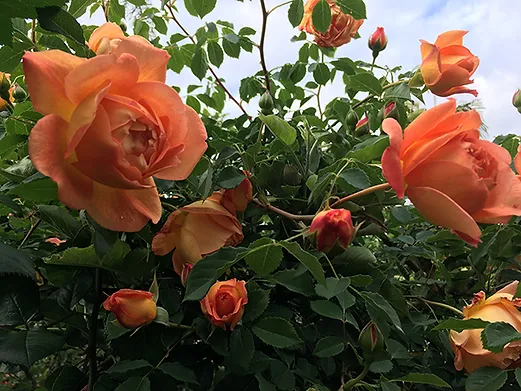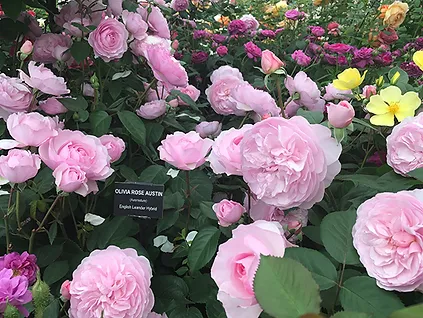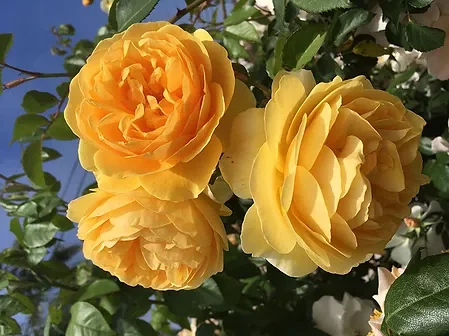by Carol Macon, Master Rosarian, Denver Rose Society, Award of Merit 2017, photos by Rita Perwich

Websites showcasing one gorgeous rose after another, with ordering starting in fall. January catalogs filling your mailbox, just in case you missed the on-line extravaganzas. How do you choose just one rose? It is definitely not easy. First of all, despite the recent demise of some rose firms and consolidation of others, there are a still lot of sources. Hybridizers still hybridize, and dozens of new varieties come to market each year. Secondly, while roses are getting better and better as garden plants, especially in terms of hardiness and disease-resistance, this does not mean that rose varieties with lesser attributes are no longer coming to market. Indeed, they are, and I shovel prune plants each fall that I previously planted with high hopes. Usually the reasons for this are the failure of the plant to thrive or a propensity to disease or both, and so I can’t pass the rose along to another gardener. Those that I, for one reason or another (mostly size, or the encroachment of shade), do give away, must at least be good garden plants, although they may be wrong for the spot in which I planted them. In these cases, I have lost my rose investment in years of growth because I chose a plant that, when mature, did not work in its designated place in my garden. So obviously, you need to know the mature height and width of any rose you plan to buy, and you must be able to give your rose at least 6 hours of sun a day in the spot you choose to accommodate its dimensions. (ABOVE: ‘Graham Thomas’)

This may be a simplistic statement, but before you purchase a rose, you must know why you want it. Do you want long-stemmed beauties to arrange in a vase? Do you want a traffic-stopping vivid splash of color in the front yard? Do you want to hide a dead tree, add reliable color to a perennial bed, edge a walkway with plants that bloom all summer, plant a drought-resistant flower bed? Do you want to grow the next Queen of Show? Once you decide on the rose’s purpose, you have automatically limited the field from which to choose. This is the antithesis to my usual method of choosing a rose because I like its on-line glamour shot or have fallen in love with a bloom in a greenhouse. (ABOVE: ‘Lady of Shallot’)

Then, and this is the toughie, you should know where you are going to plant the rose. Like many another gardener of mature years and mature garden, I have limited space for anything new. In fact, every year, I plant roses in pots that sit on our driveway, because there is no room for them in the ground. Forty- two of them used to spend every winter in our garage. These facts do not stop me from ordering new varieties every year. Now, I ask you, how smart is that? The only saving grace of my method is that I can evaluate the new, potted roses during our summer season, and use the best ones to replace older varieties in my garden in the fall. This would work even better if I weren’t so emotionally attached to those older varieties. I once had a hardy and vigorous plant of Sutter’s Gold that gave me five or six bloom cycles every summer, a miracle at our altitude of 6100 feet. I took it out to plant show star Gold Medal, and later regretted losing Sutter’s freely given garden color. See Rule 1: know why you want the rose. (ABOVE: ‘Olivia Rose’)
Now, assuming that you have a need for a new rose in your landscape, a specific need, for which you need a specific type of rose, and further assuming that you know exactly where this rose is to be planted and even further than that, you know what size rose the spot can accommodate, what’s next? Consider your garden’s location. Because we live in Colorado, where winter temperatures can remain below zero for days and then scoot to 70 degrees F, or even worse, do exactly the reverse of that; and because our growing season is short, the two most important criteria for any rose are hardiness and vigor. Without them, we won’t have that rose for long. Our rose choice must have a reputation for living a long and happy life a mile high. It must be energetic in its rate of growth and production of bloom each and every year. Now, granted that these factors are often unknown when a rose first comes to market, we can make educated guesses.
If the rose is an American Rose Society award-winner (All-American Rose Selection, American Garden Rose Selection, Award of Excellence) it has been tested for hardiness and vigor all over the USA. If you can wait to plant a couple of years after your chosen rose comes to market, its flaws, if any, will start to turn up in the American Rose Society’s annual ritual known as Roses in Review, following which a rating will appear for it in the ARS’s annually produced HANDBOOK FOR SELECTING ROSES. As a general rule of thumb, I try to buy only those varieties with a rating of 7.8 or above, which makes them above average roses and more likely to be hardy and vigorous. The handbook is mailed free to every ARS member every year, and many members refer to it when shopping for roses. I firmly believe that any serious rose grower should belong to the American Rose Society. Membership can save you time, trouble and money.
For me, the most reliable guide to hardiness and vigor in a rose is its national origin. Roses from Kordes and Tantau in Germany, Poulsen in Denmark, Harkness, Fryer and Austin in England, Dickson in Ireland and anybody in Canada, usually grow very well in our garden. In contrast, I have never managed to keep a French or South African rose alive much less happy. California roses are always iffy, and I tend to wait a year or two after their debuts to purchase them. How do you know the source of a rose? The first three or four letters of a rose’s registered (not market) name are an abbreviation of the producer’s name: Kor, Aus, Poul, Fry. And you know that by checking the New Rose Registrations section of your American Rose magazine. Be aware of Germany’s ADR designation. ADR testing for hardiness and disease resistance is the most rigorous in the world, and rose varieties with this designation are available for purchase in the USA. The Germans are very serious about their ADR Award; so serious that not only can they award it to a given rose, but they can also take it away.
The other criteria for selecting a rose are, in order of their importance to me (you may and should have your own scale), disease resistance, fragrance, form, bloom cycle frequency, substance, petal count and drought tolerance. These qualities can sometimes be determined more by what is left out of a website or catalog description than by what is actually printed. Assume that if disease resistance is not mentioned, you’ll need to spray for blackspot and mildew. Assume that if fragrance is described as light or not described at all, the rose has no fragrance. Assume that if high centers or show form are not mentioned, your rose won’t win Queen of Show. Is your choice needed for garden color and possibly, arranging? In that case, the plant should be a prolific bloomer, and the description should say so. Bloom cycles are dependent on weather and season length. Knowing what you can expect from a hybrid tea or floribunda is based much more on individual experience than it is for, say, an old garden rose which has only one heavy, early summer bloom, or some shrub roses, which will bloom heavily in spring, followed by fewer blooms thereafter, and maybe, a second flush when the weather cools in fall. Substance generally refers to the thickness, texture, crispness, firmness and toughness of the petals. It is a function of the amount of moisture and starch present in the bloom. This is a factor in the bloom’s ability to stand up to rain and other environmental stress, including hail and insect infestation. It is also an important factor in the vase life of a cut bloom, and thus, its show worthiness. Petal count is usually included in a catalog description. Too few petals may mean a rose may open and blow quickly. Brandy is a rose that has too few petals to hold its form. Conversely, too many petals may mean that the rose will never open in our climate. Uncle Joe (Toro) is an example of a rose with too many petals to open well in Colorado. And it should be mentioned here that a website or catalog listing of the height and width of a rose is based on what the rose is capable of where it was bred. If the rose is a product of Oregon or California, it usually will not attain its stated height and width where the climate is more severe. Conversely, Canadian roses, for the most part, will grow as much as third to a half again higher and wider than they do in Ontario. Austin roses may grow higher and wider here and have fewer disease problems than they do in England because our climate is sunnier and less humid.
Many shrub and old garden roses are renowned for their drought tolerance, but catalogs generally have not caught up with the current importance of this quality in a rose and seldom comment upon it. One noteworthy exception is the catalog of High Country Roses, www.highcountryroses.com, which sells drought tolerant roses. You may check on a variety’s drought tolerance with your local consulting rosarians. You may have read about Earth-Kind roses, which have been tested by the Texas AgriLife Extension Service for superior pest tolerance, outstanding landscaping performance, and heat and drought tolerance. Be aware that while they may be drought tolerant, several of the relatively few cultivars with this designation are not truly hardy and vigorous on the front range of the Rockies.
So now you know how to choose a rose. Just don’t fall in love in a greenhouse.





























































